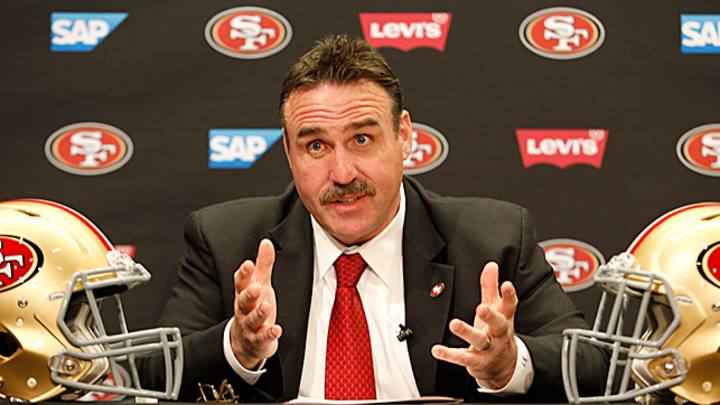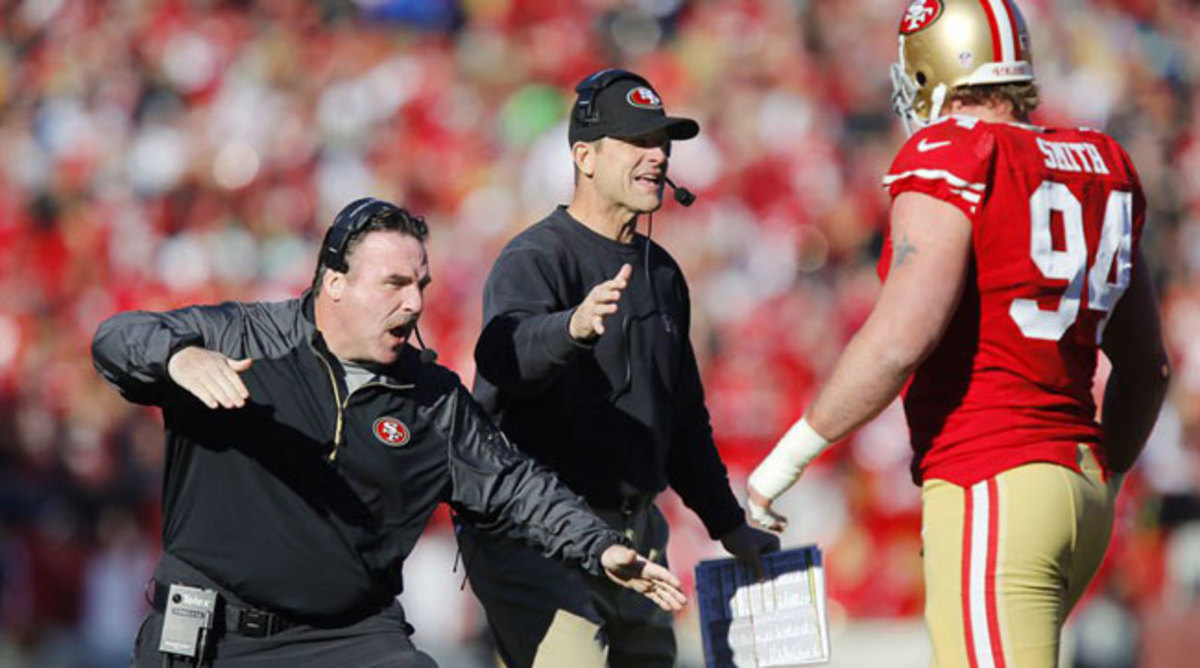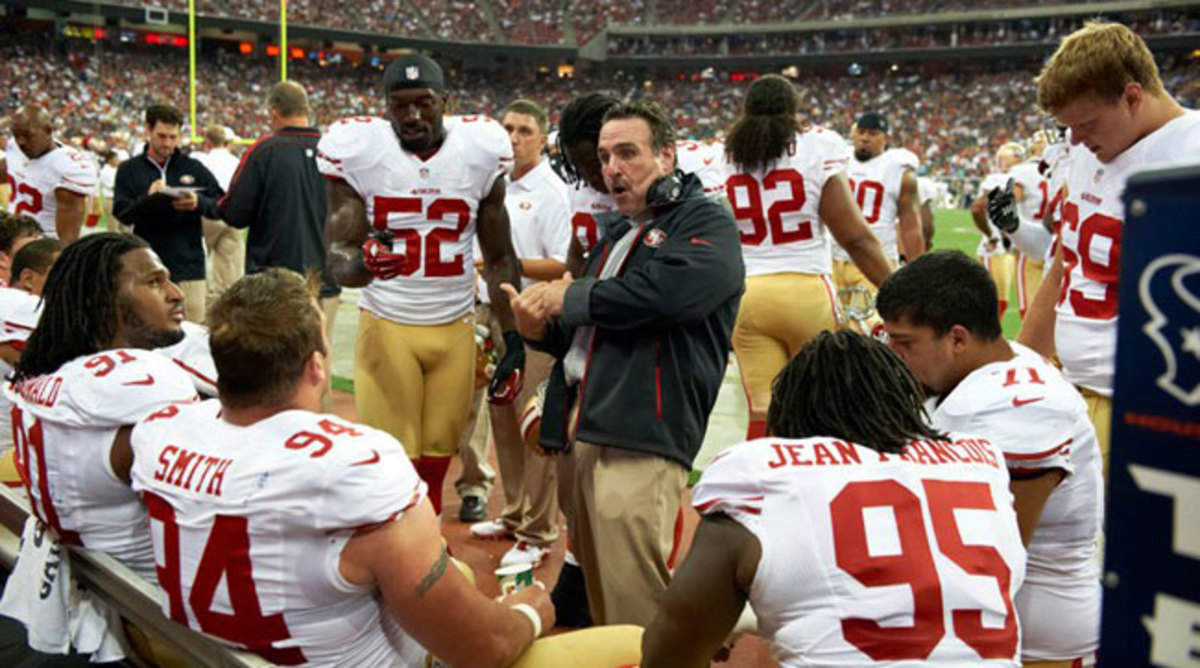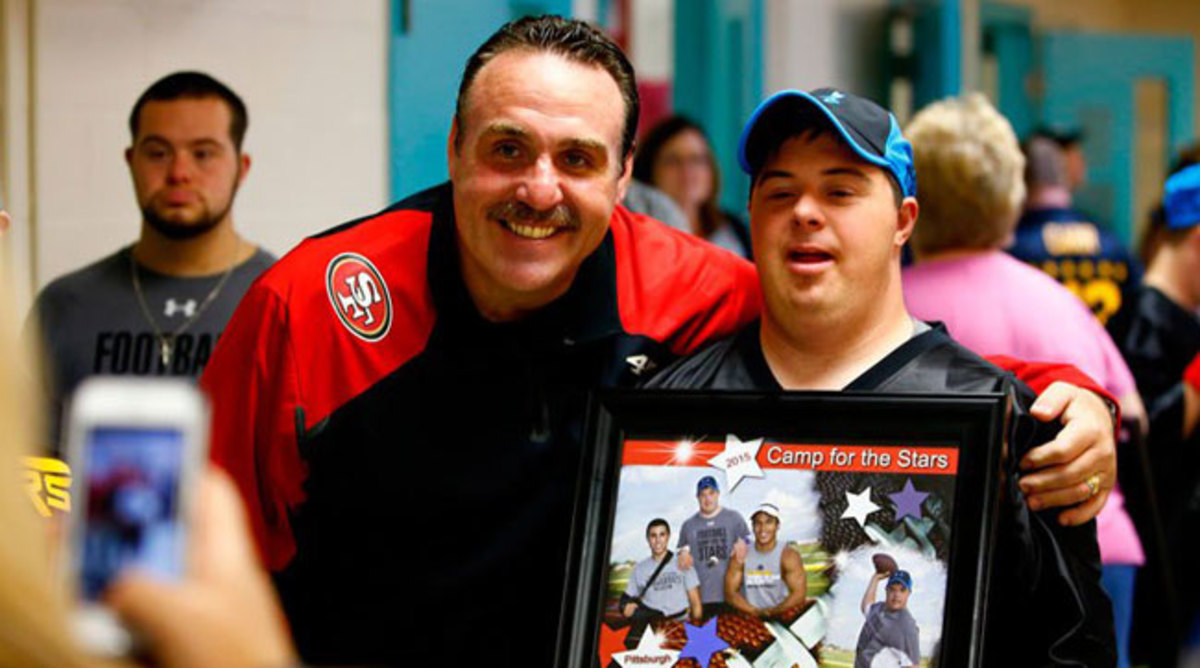Don’t Bludgeon the Man

The most recognizable man in San Francisco is going unnoticed in his hometown. It’s an overcast Friday in late June, and new 49ers coach Jim Tomsula is nursing a 31-ounce coffee on the patio of a Starbucks in Homestead, Pa., just on the outskirts of Pittsburgh. He’s packing a wad of tobacco in his left cheek (a regular habit), wearing a nylon tracksuit (his sartorial preference) and sporting the kind of thick, dark mustache that harkens back to the leading men of 1980s TV shows (“a mustache to be reckoned with,” according to his mustache’s parody Twitter account). A group of teens loudly gossips at an adjacent table, and a steady stream of shoppers walk through the strip mall. Nobody stops to look twice at Tomsula.
If he had his way, this would be the norm. No fame, no media attention, no conjecturing about who he is or what his team will be.
“I don’t care about perception, I care about reality,” Tomsula says in a husky voice that sounds like the natural bark of football coach. “I try not to read what’s out there, but sometimes I do and just laugh. I mean, some of the reports out there couldn’t be further from the truth. It’s the exact opposite of the reality that I’m dealing with. The exact opposite! Seriously, the exact opposite!”
He spits out the tobacco.
“But, I guess, that’s the NFL.”
In a league in which perception is everything, Jim Tomsula was a nobody before mid-January, when he made the gargantuan leap from defensive line coach to one of the NFL’s Chosen 32. After being introduced to the press, he sat down for an exclusive one-on-one with the TV network CSN Bay Area that had all the makings of an SNL skit. Like his press conference, this four-minute interview was full of uncomfortable pauses, mutterings, contradictions and non-answers. To one question he replied, “I wouldn’t not say that. I wouldn’t say it either.” His predecessor—the gauche and irascible Jim Harbaugh, he of the khaki pants and beige answers—suddenly seemed as eloquent as a Shakespearean actor. Asked to define a successful first season, Tomsula said, “Uh…that’s yet to be determined. I mean, uh, we’re gonna, uh, we’re gonna, we’re gonna win today. That’s, our, uh, uh, you know, it’s, it’s one week calendars once you get into the season. So that’s the way I look at it.”
And so everyone looked at Tomsula for what he was: an unpolished assistant who had been promoted so far out of his depths that it was impossible not to wonder if the front office, having grown tired of clashing with Harbaugh, had installed a puppet whom the powers-that-be could control. As Tim Kawakami from the San Jose Mercury News wrote, “Tomsula will say the things the 49ers want him to say, in the way they want him to say it.”
Then, as if perception couldn’t get any worse, Tomsula’s players started bailing on him.
* * *

General manager Trent Baalke shoots down the idea of a “mass exodus” or a “domino effect,” but it was hard not to wonder about the sudden departures.
In March, stalwart linebacker Patrick Willis said a teary goodbye to football. A week later his heir apparent, Chris Borland, stunned everyone by retiring at 24. In May, defensive lineman Justin Smith walked away from the game after 14 seasons. A month later, 25-year-old offensive tackle Anthony Davis cryptically quit. The 49ers also bid farewell to wideout Michael Crabtree, guard Mike Iupati and the franchise’s alltime leading rusher, Frank Gore, in free agency. Rumors that quarterback Colin Kaepernick was being dangled for a trade only added to the offseason malaise. “Let’s put that to rest,” Baalke told The MMQB in June. “That’s absolutely untrue.”
What’s undeniable is that Tomsula, who has never been a coordinator in the NFL, is now juggling the most intense expectations of his career. San Francisco’s run of three straight trips to the NFC Championship Game went sideways during a tempestuous 2014 season, and fans aren’t likely to give the least qualified of eight coaching candidates an extended honeymoon period. But Tomsula isn’t fazed. With pop music blaring through nearby speakers and threatening skies looming overhead, he retraces his unlikely journey and ascension, never at a loss for words when describing the obstacles he’s already overcome.
“I feel bad when people talk about the grind of coaching,” Tomsula says. “My people? They work. That’s all they know. And they weren’t working for a job they loved, just for the responsibility for their family. Growing up, I was always told never to let pride get in the way of a job.”
His great-grandfather was a Hungarian immigrant who worked in the coal mills of Indiana, Pa, where he was hit by a coal pulverizer and died on the job. Despite not knowing how to drive, his widow packed her four kids in the car and crashed twice on her way to Homestead, where she was able to find work washing the floors of churches. Years later Tomsula’s grandfather opened a restaurant, Hungarian Village, in the shadow of Forbes Field, the one-time home of the Steelers and Pirates. Tomsula’s father worked in the kitchen. When Forbes Field closed in 1970, so did the business. Everyone had to find new jobs.
“I never had a dream to coach in the NFL in my life,” Tomsula says. “I’d be happy coaching at any level, anywhere. I just wanted to coach and pay the bills.”
Jim Tomsula himself has always been a worker. Uncle Dave taught him how to weld stainless steel in third grade—“that was a big deal,” Jim says—and his teenage summers were spent laying bricks, a back-breaking trade that helped mold him into a stout defensive end in high school. In 1985, he left home to play football at Middle Tennessee State, then transferred to Catawba College, a Division II school in North Carolina. That’s where he met his future wife, Julie, a student athletic trainer.
“When he graduated, everyone said he should become a coach,” Julie says. “He said, ‘No, I’m going to go make a lot of money.’ ”
So Tomsula got a six-figure job in Greensboro selling medical equipment. But it didn’t take long for Julie to realize he wasn’t happy, and at her urging he walked away from the money. In 1992, Tomsula became an assistant football coach at Charleston Southern for $9,100 a year.
“They also said we could get our masters,” Julie says. “So we thought it was a great deal.”
But they couldn’t afford books or much else. Tomsula supplemented his income with side gigs, working as a janitor, delivering newspapers, and chopping wood for $55 every third truckload. It still wasn’t enough. His father visited and was flabbergasted to find the cabinets bare. Not even a jar of peanut butter. “What are you doing?” he asked. “You can’t provide for a family like this!”
After three seasons, Tomsula returned to Pittsburgh and became a sales rep for a food distributor. But, he says, “I wasn’t good at the whole networking thing.” Division II and III college teams often called about coaching opportunities, but Tomsula always passed on them—until Julie intervened again. “Life is too short,” she said. “Do what you love.”
In 1997, Julie took their two daughters, Britney, 4, and Brooke, 2, to stay with relatives in Florida while everything they owned was put in storage. And so began the year that Tomsula lived in a car, a red Cadillac given to him by his Uncle Tic. Tomsula drove the 430 miles down to Catawba and became an unpaid volunteer assistant at his alma mater, charged with strength and conditioning. He slept in parking lots and cleaned himself up in the locker room. To combat loneliness, he kept a black lab and a cat as roommates. Tomsula hung his suits in the back seat, right above the litter box.
“Ah, the homeless period,” he says. “Everyone makes it out to be a bad thing, but it really wasn’t.”
Tomsula sold carpets for commission on the side. The next season, he became a salaried coach. His wife and daughters joined him, and Tomsula moved his family into a $650-a-month fishing cottage 25 miles away from campus. They didn’t have heat.
But they did have a phone line, and former NFL wide receiver Lionel Taylor cold-called Tomsula in 1998 and asked him if he’d be interested in joining his staff in NFL Europe. Tomsula had never met Taylor, but Tomsula had established a reputation as a teacher of fundamentals, making him a desirable assistant for the developmental league.
For the next nine years, the Tomsulas spent their autumns in Catawba, where the school provided on-campus housing, and their summers overseas. He was the defensive line coach for the English Monarchs for one season, the defensive line coach for the Scottish Claymores for five, the defensive coordinator for the Berlin Thunder for two, and then the head coach of the Rhein Fire in 2006.
Every August, Tomsula toured about a dozen NFL training camps, looking for fringe players who might play in Europe. Some teams allowed him to sit in on personnel meetings, and he’d walk away with dozens of notebooks filled with observations of how coaches talked, what they talked about, how they conducted themselves.
In January 2007, Tomsula received a most unexpected call: 49ers coach Mike Nolan was looking for a defensive line coach. Though they played on the other side of the ball, offensive linemen Harvey Dahl and Tony Wragge had returned from Europe raving about Tomsula’s mentorship. The 49ers flew Tomsula out for an interview; it was the first time he ever rode first class. Tomsula accepted the job, but first asked Nolan an important question: “I don’t know anything about money. Can I live with my family in California and provide for them with that salary?”
Nolan told him yes, and then boosted his salary $10,000 on the spot.
“I never had a dream to coach in the NFL in my life,” Tomsula says. “I’d be happy coaching at any level, anywhere. I just wanted to coach and pay the bills.”
* * *

It’s true that Jim Tomsula knows very little about money. One of the first people he thanked during his introductory press conference on Jan. 15 was Joan from payroll, who doubles as his personal finance adviser. Tomsula has come a long way from that $9,100 a year job. The 49ers signed him to a four-year deal worth $3.5 million a year, but the new riches haven’t changed him. He also gave shout-outs to Vilma at the front desk and the kitchen crew—the “boys downstairs [for] making that great Mexican feast at Christmas.” Every day at 8 a.m. ET, the coach calls his parents at their home in Pennsylvania. He is usually in his office, and he has usually just pulled an all-nighter.
Over the course of Tomsula’s eight seasons coaching the defensive line in San Francisco, the 49ers ranked fourth in rushing yards allowed (98.4 per game) and third in points allowed (19.4). He molded Ahmad Brooks (supplemental draft), Isaac Sopoaga (fourth round) and Ian Williams (undrafted) into productive starters. Justin Smith never made a Pro Bowl until he worked with Tomsula.
“As an X’s and O’s coach, there’s nobody better,” Smith says. “But he’s not going to be doing as much of that anymore. As head coach, he has to do the stuff he hates: dealing with media, dealing with ownership.”
Tomsula knows he didn’t handle his introductory press conference or the ensuing CSN Bay Area interview with the greatest aplomb. He didn’t sleep the night before and was in crunch mode trying to assemble his staff. The communications department carved out an hour to go over any possible questions that reporters might ask, and Tomsula aced the run-through. But he froze in the spotlight. Tomsula says he was singularly focused on returning to his office to continue calling potential assistants. Plus, he didn’t want to say anything that could be used against him. If, for example, he said he preferred a certain blocking scheme, would Tony Sparano be hesitant to become the tight ends coach?
The next day, 49ers CEO Jed York told his new coach, “Don’t act or try to be someone you think the media wants you to be. From now on, just be yourself.”
“If there’s ever a time I mess up or seem awkward in an interview, it’s because I don’t want to lie,” Tomsula says. “Really, that’s all it is.”
“As an X’s and O’s coach, there’s nobody better,” Smith says. “But he’s not going to be doing as much of that anymore. As head coach, he has to do the stuff he hates: dealing with media, dealing with ownership.”
Tomsula handled himself with greater authority in assembling his staff. His first call was to Bill Nayes, the longtime director of football operations under Mike Holmgren in Seattle and Mike Singletary in San Francisco. The job is essentially a chief of staff: part-assistant, part-confidant. From booking travel to scheduling mini-camps, Nayes knows the minute-to-minute needs of a coach. This was crucial for Tomsula, whose only previous head-coaching experience in Europe doesn’t quite translate to the NFL. When Tomsula first joined the NFL, he told friends, “It’s amazing, I no longer have to carry the equipment!”
Tomsula sought out assistants who would challenge him. Eleven of the 19 have been head coaches or coordinators either in the NFL or at the elite levels of college football. The next order of business was logistical. The head coach’s office was on the second floor. Tomsula felt it was too far removed from the action, especially during the summer months when the NFL limits the contact he can have with players. The locker room, training room and meeting rooms are all on the first floor, so Tomsula chose a new space in the middle of a hallway where players would have to pass by him every day. While maintenance crews prepared the room this summer, Tomsula set up shop in a small enclave next to the showers.
“Culture is huge. That’s the difference between a championship-caliber team and a championship team,” York says. “You look at the Golden State Warriors. They were the dumbest team in the NBA for letting Mark Jackson go, who won the most games in the franchise’s history. How could you be so dumb? They bring in Steve Kerr, who has been around the game for a long period of time but has never coached before. Kerr changes the culture, comes in with a different perspective, and look what happens.”
But Tomsula actually has been an NFL head coach before. During the final game of the 2010 season, he served as the interim head coach after Singletary was fired and rallied the 49ers to a 38-7 win over the Cardinals. A year later, according to York, the team identified a few internal candidates who could be potential future head coaches. Tomsula was on the list.
“No player has seen a position coach get promoted to head coach just like that, without being a coordinator first,” Smith says. “That’s a huge jump. But I think it just shows the respect Jimmy T. has from management, which is a good thing. Imagine the star wide receiver is upset and wants to complain to management. If he goes upstairs, he knows which side they are going to fall on.”
Players love him, too. He’s fiery when he needs to be—just do a quick search for “Jim Tomsula Bludgeon”—but tries to be low-key in meetings rooms to avoid overloading players with information. He’ll often say, “Hey, here’s what I’m thinking. What do you think?” Last season, when Frank Gore was distraught after losing a fumble in a 13-10 loss to the Rams, it was Tomsula who sat hunched on a stool by the running back’s locker to console him.
[youtube=https://www.youtube.com/watch?v=T6Sr8VI_TaI&w=800&h=533]
Even still, there was a nervous energy in the auditorium just before Tomsula was set to address his players for the first time as the head coach during April’s minicamp. “Everyone kind of looked around like, How’s it going to be?” says defensive end Ian Williams.
Was it going to be the same Jimmy T. who struts around the facility yelling to no one in particular, “We’re going to do some ass-kicking this week!”? Or would this be a buttoned-up Jim Tomsula?
The coach opened his mouth to speak and was loud, passionate and even a bit goofy. The nervous energy dissipated. He was exactly the same.
“I’ve only been here a short time,” says veteran running back Reggie Bush, a free agency addition. “But I can already tell how much respect this team has for him.”
* * *
Jim Tomsula, 47, spent his first summer vacation as an NFL head coach crashing at his parents’ split-level colonial in suburban Pittsburgh. His wife, Julie, and 8-year-old son Bear, came along. Britney and Brooke, now college-age, stayed in the Bay Area. Tomsula woke up to mom’s bacon and eggs, threw the pigskin in the backyard with Bear, and washed loads of workout clothes emblazoned with 49ers logos in the basement.
On one humid afternoon in June, he loaded two sedans with three generations of Tomsulas and headed to Thomas Jefferson High School for the highlight of his homecoming: his sixth annual football clinic for teenagers with Down syndrome. The coach knows he could ask the NFL to help sponsor the event, but says, “It’s a Tomsula thing.” Campers dine on burgers flipped by Jim Tomsula Sr. and cookies baked by the coach’s aunts. They even prepared a gluten-free batch, to which Tomsula Jr. scoffs: “Kids these days.”
Camp for the Stars began in San Francisco, in 2007, to give kids who have Down syndrome an authentic football experience. Tomsula loved it so much he brought the camp back home to Pennsylvania. Throughout the two-day camp, Tomsula co-leads drills with his old football coach from Steel Valley High. Even though the campers wear nametags, Tomsula remembers most of their names without looking. He puts players through one drill that has them catching a ball in the air before falling onto a thick mat. For those wearing red bracelets, signifying a greater risk of injury, Tomsula holds them up in the air and then flops onto the foam with them to brace their fall.
“Hey coach,” one camper says after such a fall, extending his arm to Tomsula. “I have to help you get up a lot this year.”

While Julie is off scouring two Targets and a Michael’s to make sure every participant leaves with a framed certificate, Bear is working the field as a water boy. Two 49ers scouts are also here volunteering, as well as retired defensive tackle Dana Stubblefield, who never played for Tomsula but says, “He’s just a really good dude.” So Stubblefield booked a cross-country ticket and a room at the local Spring Hill Suites.
It’s all smiles until the scrimmage. Before one snap, a camper tells another that he is stupid. The recipient of the slight responds with an uppercut. He then rips off his own hat and storms off into the locker room.
Tomsula tells Stubblefield to continue coaching and follows the player into the locker room. He sits the boy down and talks about the importance of sportsmanship. “The game teaches us to become men,” Tomsula says. “And we need to act like that.” Fifteen minutes later, the camper and Tomsula emerge. The boy walks to his opponent, says he’s sorry, and shakes his hand.
Around 10:30 p.m. on Friday, once the last camper has hugged Tomsula goodbye and once the cafeteria has been wiped clean, an after-party commences at the house of Tomsula’s sister, Jill. Nearly 50 relatives, neighbors, friends and one 300-pound former All-Pro lineman grab Miller Lites from a porch cooler and munch on potato chips and leftover burgers in the kitchen. There’s a glow inside the house. No music, but laughter. Old stories are retold about karaoke nights gone awry and summers at the Jersey Shore. When midnight strikes, Jill notices something isn’t quite right.
“Where the heck is Jimmy?” she asks. “He’s the toast of this damn thing!”
Soon the door swings open. It’s Jimmy, and he’s wearing one of his signature nylon tracksuits that leaves him perpetually sweaty. “I’m sorry, I’m sorry,” he huffs. “I had to drive Uncle Tic home.”
“It took that long?” Jill asks.
“It’s late! It’s dark!” he says. “I had to make sure he got in OK.” Consider it part of Tomsula’s code: When someone gives you a car, the least you can do is make sure he always has a ride. And this too: he downs a beer and devours an Italian hoagie with the urgency of a two-minute drill. Then he goes about working the room with salami-and-suds-doused breath, doling kisses and pats on the back.
“We did great work today,” he says. “I love you people.” He grabs another beer. “Really, I love you people.”
Tomsula’s mother, Betty Jo, beams with pride.
“Folks in San Francisco or around the country might say this or that about Jim Tomsula the football coach,” she says, “but I know this is the real him.”
